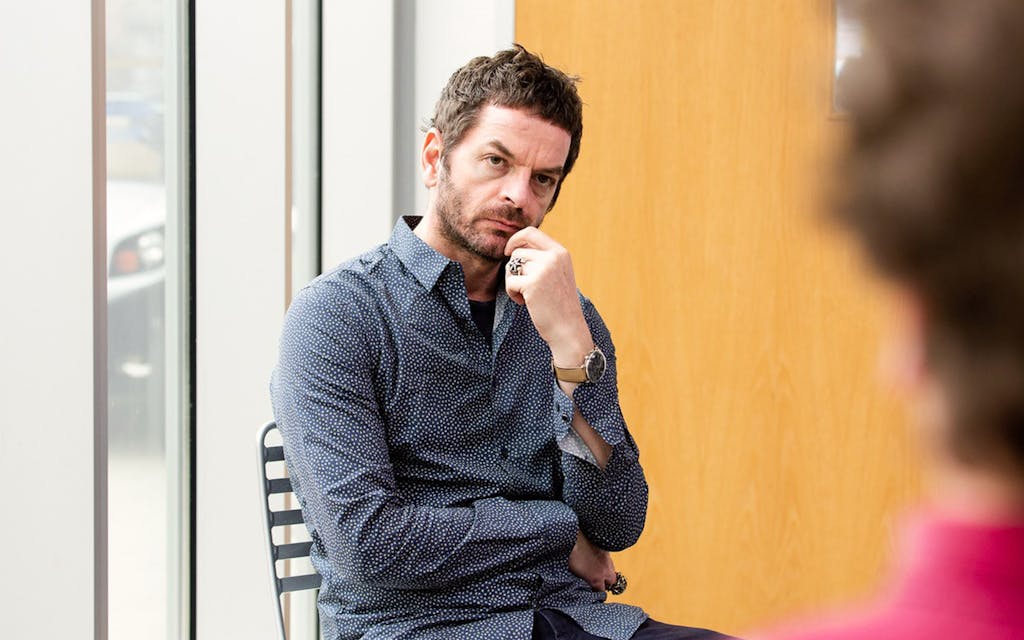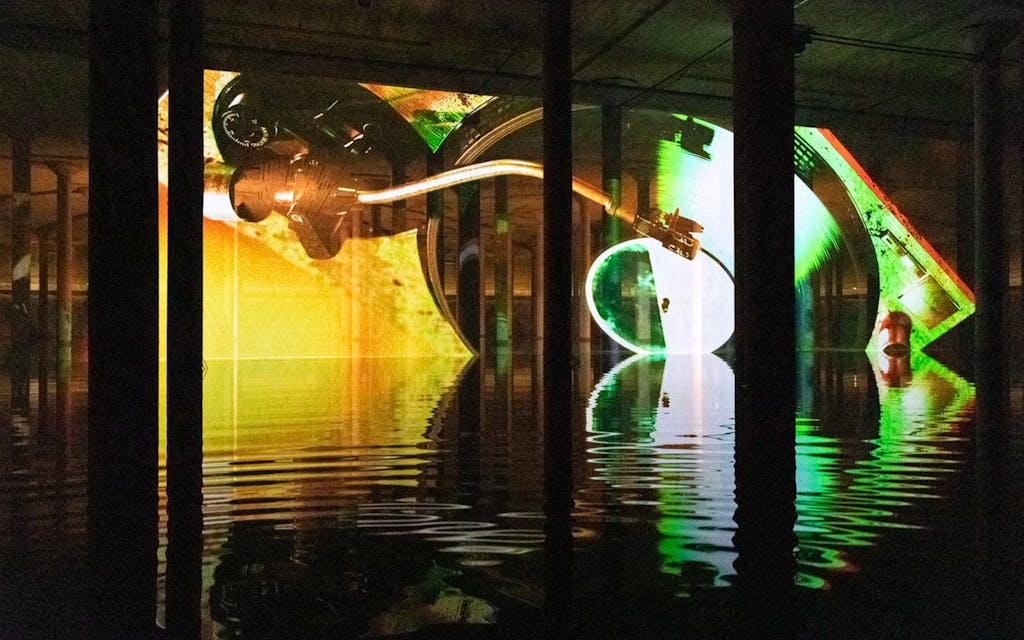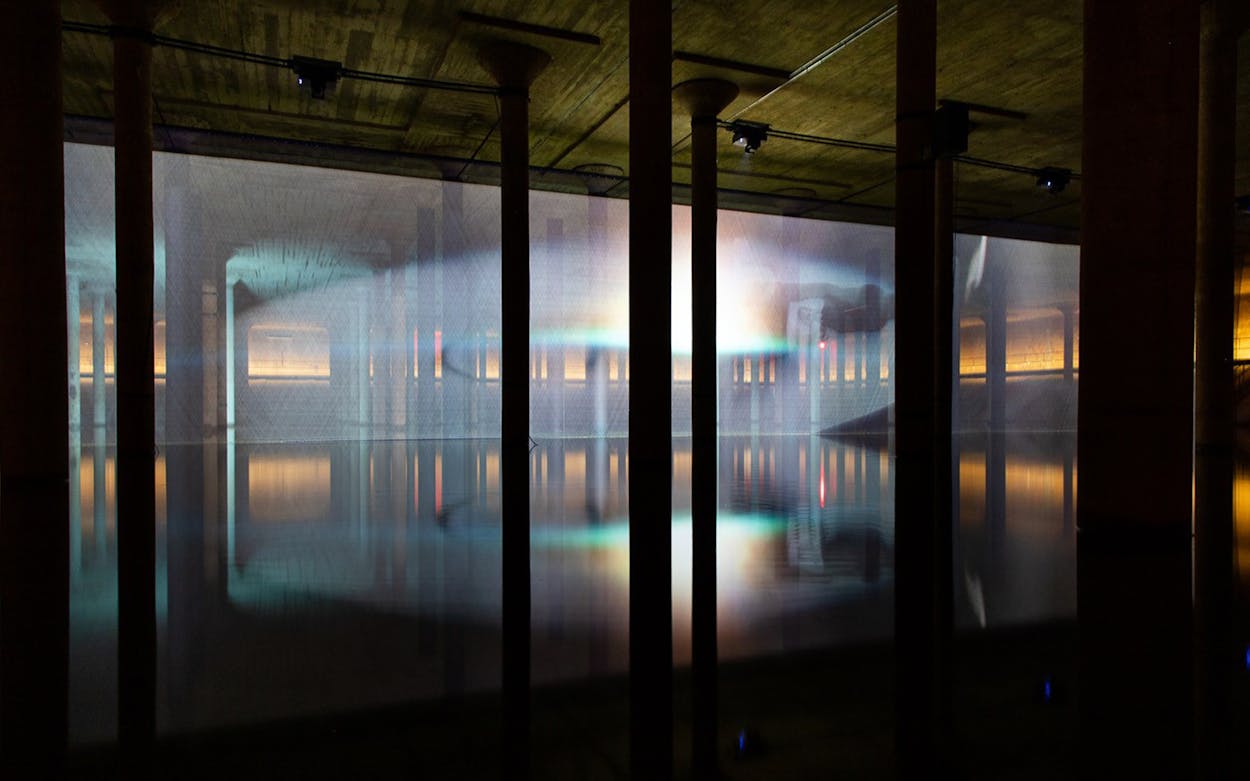At the center of Time No Longer, Berlin-based artist Anri Sala’s new site-specific video-and-sound installation in Houston’s cavernous Buffalo Bayou Park Cistern, is the projected image of a record player floating in a space station after some unspecified disaster. With humanity absent, the record is left to revolve eternally on its turntable, inside a forgotten bit of space junk likewise circling the earth.
All we see on-screen is this abandoned machine within an abandoned machine, with a backdrop of the drifting cosmos occasionally appearing through a window—there are no people and no dialogue in Sala’s film. It’s a stark vision, but an affecting one. Who among us hasn’t felt, at some point over the past year, as if we were living out an endless loop in the wake of a fatal catastrophe?
And more than that: As the turntable tumbles in zero gravity, its stylus (or needle) occasionally makes contact with the record, then loses touch, then connects again, at a different point on the record. But the connection never lasts for long.
Over a year spent in various stages of lockdown while making this immersive artwork a reality, Sala says he began to relate deeply to the stylus’s “desire for contact or traction,” a yearning that, he says, “I think one can apply emotionally to the whole last year.”
“I felt like the stylus pretty often,” Sala admits.
It has been a difficult year, too, for those who find community, meaning, and joy in crowded exhibition rooms, concerts, and other communal cultural events. Sala’s cistern installation is a fitting place to get your feet wet again, so to speak, in the world of post-vaccine shared indoor art experiences. Open as of last week, the installation will be up through December 12, so there is no rush to make a plan to visit safely.
The Buffalo Bayou Park Cistern, just across Interstate 45 from downtown and city hall, is worth the visit in its own right. An underground chamber the size of 1.5 football fields, it was built in 1926 to store up to 15 million gallons of drinking water for the growing city. Sala’s installation bisects this space with a 143-foot semi-transparent screen, which permits us to see through to the other side of the cistern when dark objects or the black cosmos occupy the screen. The cistern was decommissioned in 2007 and later renovated to host school tours and healing meditation classes. Art installations began in the space in 2016; Sala’s is only the third.
The site provides a number of interesting limitations and opportunities for a site-specific artist, including a vast pool of reflecting water, a seventeen-second echo, and an array of 221 concrete columns that hold up the ceiling and divide the space visually into an uneven grid that changes based on the viewer’s location around the perimeter walkway. Sala says the columns made him think of a GPS system or 3D-grid-style map of the stars. “I thought of the cistern being like a universe that the columns are carrying, a bit like Atlas in Greek sculpture,” he says.

Sala, an Albanian-born artist who represented France at the 2013 Venice Biennale art fair, says that he mostly conceived of Time No Longer before COVID-19. Sala initially wanted to make something that related to Houston’s legacy as an embarkation point for exploration and exploitation. He speaks of trying to draw out this theme in three dimensions: the horizontal (the old Western frontier), the underground (oil and gas), and the cosmic (NASA and the Johnson Space Center). He is also a believer, however, in following instinct to unexpected outcomes.
“In the way I work, I always try to find a moment where I break with the logic and intuition takes over,” he explains. “Somewhere in the middle, when you don’t remember where you came from and you don’t know yet where you’re going, when you can’t trust your brain, but you can trust your intuition, so to say.”
This sincere searching process led Sala through the conception of Time No Longer. He began with the idea of a tribute to pioneering Black astronaut Ronald McNair, who died in the 1986 Challenger space shuttle disaster. A small element of the Challenger mission was to have McNair, an accomplished saxophonist, create the first-ever recording of original music in space, which would then be incorporated into a larger composition by 1980s New Age music superstar Jean-Michel Jarre. This recording, of course, never came to pass, as McNair died when the Challenger exploded shortly after liftoff.
As regards McNair’s ill-fated recording, Sala says that his vision was not to “play God” and complete the Jarre composition. Instead, he sought to ask, “What is the soundtrack of an intention?” That question eventually led Sala to the image of the post-catastrophe turntable floating in space and the lonely stylus reaching out every so often for precious contact. It was only later, in retrospect, that it became clear to him what a potent metaphor he’d created for the COVID-19 experience. Sala also suggests that the work could be interpreted as a vision of technology outliving humanity after some much larger-scale disaster, or after robots have replaced us.
“Maybe there is some form of an end of humanity as such, but not necessarily the end of human sensibility,” Sala says of his vision. That partial survival is symbolized in the familiar, domestic image of the eighties turntable.
There remained for Sala the question of what music to employ for the moments when the stylus and record are in contact. If not the Jarre song, then what? Sala felt drawn, again, perhaps presciently, to music created in extreme isolation. He chose the Quartet for the End of Time by Olivier Messiaen, which he calls “the most famous piece of music ever written in captivity.” Messiaen composed the quartet while a prisoner of war in a German World War II camp, writing for the instruments and fellow prisoners he found locked up with him. The composition is built around a famous, mournful solo for clarinet.

“It was this idea of how to make two voices not sound like a duet, so it still keeps the [sense of] solitude, but you bring some empathy in,” Sala says of the composition process. “The moment you have two, you have empathy, because you have a relation.” Sala likens the saxophone part in the Time No Longer composition to the “breaking of light” through a prism. Messiaen’s clarinet solo is the white light in this metaphor, and the saxophone part is the “breaking of the sound of the clarinet in space—as if the physical conditions of space made it break its sound, so it gives it this otherworldly presence.”
Like all of us during the pandemic, Sala had to work around unexpected limitations. For instance, he had hoped to consult with NASA engineers in Houston on the laws of physics for his CGI film, but wound up talking to French experts instead, because of travel restrictions.
As a site-specific artist, Sala does not shy away from these obstacles. Time No Longer, finally realized this spring as pandemic regulations in the U.S. begin to loosen, can be viewed in the same spirit as Messiaen’s composition: it’s the product of friends and coconspirators working together in a time of challenge and constraint, led by intuition and a vision of transcendent beauty.
“I think it’s a very strong idea that, composing, you are not thinking of instruments that are there to serve at your pleasure,” Sala says of Messiaen’s inspiration. “You are thinking of human beings who are able to pull it off and make something with you in those conditions.”






